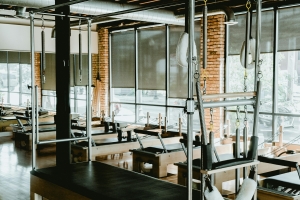Importance of Weight Training in Over 65's

A US study published in the British Journal of Sports Medicine (BJSM) has suggested a link between life expectancy and certain physical activities.
Whilst it has long been known that we benefit from physical activity as we age, what has not been clear is what specific activities have the greatest impact. In summary, the research found that the combined activities of aerobic exercise with muscle strengthening work have a positive correlation on how long we live.
Aerobic Activity
Most research to date has focussed on the benefits of aerobic exercise on our health and wellbeing. And there is plenty of research dating back to the 1980’s that links aerobic activity and life expectancy. By aerobic exercise we mean taking part in any activity that requires your body to use oxygen to create energy. This includes activities like cycling, running and swimming, or any activity where you need to breathe harder so that your heart is working faster that when at rest.
The research published in the BJSM refers to MVPA-moderate to vigorous physical activity and supports other research in establishing clear links between MVPA and life expectancy.
Muscle Strengthening Exercise
There is however little research on Muscle Strengthening Exercise (MSE)and mortality. By MSE we mean the moving and lifting of objects, where your muscles work against some form of resistance. In a gym this would involve either free weights or a machine. This lack of research is surprising when we consider how popular MSE is.
The study was therefore keen to establish if there were any links between mortality and MSE but also to see if there was a relationship between mortality and MSE plus aerobic activity.
The Cohort
The study was run by a team from the National Cancer Institute in Maryland and the University of Iowa. It commenced in 1993 and included over 150,000 people aged 55-74.
Participants were asked about how many hours they spent a week on weight training and also how many hours they spent on moderate to strenuous aerobic activities. This data was logged alongside the mortality data from this cohort.
The Findings
The research found a clear link between life expectancy and lifting weights. Those people who lifted weights once or twice a week, with no other exercise, had a 9% lower risk of dying from any cause (except cancer). But those who lifted weights and mixed that with aerobic exercise had a 41% lower risk of dying.
The people in the cohort who benefitted the most were following current US guidelines, taking at least 150 minutes of aerobic exercise per week plus muscle strengthening work two or more times a week.
There are some points that should be made in regard to the research. The research did not gather data around the details of the weightlifting i.e., the intensity of those workouts. It also focussed on people in older age groups, so many have commented that it is unclear how this impacts on young people. Another point is that the research did depend on participants remembering how much exercise they had done over a year at one point in the year, which could have led to some small degree of human error in the calculations.
Women in the Research
The other interesting finding in the research is that it seemed that female participants in the study benefited more from weight training than men. Yet women often seem to shun this form of exercise most commonly through fear that they will develop too big muscles.
Women also often report that working out with weights in a public gym can be too intimidating, particularly if the gym is busy with men working out with weights. Let’s deal though with the big myth-big muscles!
Women, Weights and the Big Myth
What often prevents women from using weights is the idea that they will overnight start looking like a bodybuilder. And as the research has linked muscle strengthening work to life expectancy it’s really important we debunk this myth. Why is it not true?
The first point to make is that it is actually quite hard to build muscle like Arnold Schwarzenegger, in fact you would have to dedicate yourself to years of weightlifting to start to get a body like a body builder. Working with weights a few times a week is not going to build huge muscle.
Women also simply do not have the testosterone that men do to build this level of muscle. Most women also do not eat enough calories to build that level of muscle. So rather than being concerned about being ‘bulky’ we need to change the language here.
If you are a woman and you consistently work out with weights on a weekly basis, use good form and eat well then you will become more healthy and ‘toned’ not ‘bulky’.
Why is Weightlifting Good For You?
So, we now know that weightlifting each week can lower mortality rates. But why would this be? Evidence from other research suggests that weightlifting improves body composition and trims fat. This is because working your muscles burns calories and enhances the ratio between fat and muscle-this is what is meant by body composition.
There could be several other reasons why strength training is so good for us. Firstly, we know that strength training helps counteract the age-related decline in muscle mass and strength known as sarcopenia. Sarcopenia was always viewed as something inevitable with aging-you lose muscle mass as you age and therefore you may struggle for example to get up out of a chair. But it is now believed that resistance training can help prevent this happening.
A second idea is that strength training improves your balance which may help prevent falls as well as helping to increase bone mass and mineral density. Skeletal muscles also produce cytokines which help prevent inflammation, so can help protect us against chronic diseases.
Another consideration is that lifting weights is great for your heart health. We know it improves circulation and may reduce the risk of a heart attack or stroke. This is because strength training will, as we have described, give you a leaner muscle mass so you will experience less pressure on your arteries therefore improving the health of your heart.
How to Start Weightlifting
One of the first things to say here is that if you are unable to go to a gym then you can always purchase free weights to use at home. But weightlifting is also a part of your everyday life, from carrying the shopping to working in your garden. In fact, the researchers were keen to point out that activities like push ups, Pilates and burpees would also count as muscle strengthening.
The NHS has also provided guidance of what type of activities can be classified as muscle strengthening and these include, in addition to the ones we have already mentioned:
- Yoga
- Tai chi
- Using resistance bands
- Any exercise that uses your body weight such as sit ups
So, key here is the point that you don’t need to join a gym to carry out muscle exercises. In fact, starting at home with free weights could be a great way to build confidence for then going into the gym. If you want to start at home, then dumbbells are often seen as a great way to start.
Dumbbells come clearly labelled with the weight and can be used in a wide range of exercises from simple bicep and triceps curls to holding them in your arms as you squat. Resistance bands are also a fairly inexpensive way to add muscle training at home and they take up almost no room at all.
In Summary
So, the research is clear that as we age a mixture of aerobic exercise combined with lifting weights is linked to greater life expectancy. As we have shown this can be achieved through exercises in the home or with the use of gym equipment. The advice would always be to start slowly, build good form and always seek professional advice.
References
British Journal of Sports Medicine - https://bjsm.bmj.com/content/early/2022/08/08/bjsports-2021-105315 (27th Sept 2022)
Eureka Alert - https://www.eurekalert.org/news-releases/965774 (27th Sept 2022)
BBC - https://www.bbc.co.uk/news/health-63048474 (28th Sept 2022)





